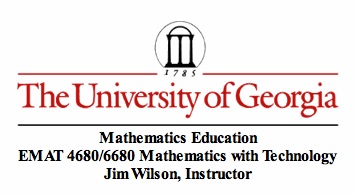

This investigation focuses on the construction of a tangent circle to two given circles. The two circles may be located within one another or the circles may be completely disjoint. Regardless of these facts, the tangent circle can be created. The first aspect to notice is that this construction is to be completed on GSP or some type of geometric software which allows students to actual discover the mathematics. In addition, using geometry software makes a construction like the tangent circles much quicker. This is not an obvious construction; thus, having the ability to try several things and reset when it doesn't work is very advantageous. The ability for students to self assess their work is also a benefit. As students try to create the tangent circles, some students may just create a circle that is tangent to two particular circles; however, as they begin to move the circles or any relevant points, they will see that their circle is no longer tangent to the others. Therefore, they need to try again. Students are able to work at their own pace and apply their own prior knowledge regarding circles and general geometric facts.
 |
To the left is a image of the construction of the tangent circle given two circles with one within the other. This construction was made in Geogebra. Click Here to manipulate the size of the circles and see what happens. |
The task of having students construct the tangent circles is not simply used to give students the opportunity of constructing a tangent circle and then never see it again. There are many more benefits of having students attack this problem and reason through various options for solving it. According to Smith & Stein's 5 Practices for Orchestrating Productive Mathematical Discussions, this task would actually be considered a high cognitive task. More specifically, this would best fit within the "Doing Mathematics" category (Smith and Stein, 2011). As students approach this task there are no explicit directions regarding what should be done. All they are given is the basic information that there are two circles and we want to find a circle that is tangent to each. Thus, students will have to draw from their prior knowledge of geometry, specially circles, radius, angles, perpendicularity, distance, and the connections between these factors. In addition, students are required utilize their ability to reason, deduce, mathematically to ensure that their process and/or conjectures are mathematically sound.
Furthermore, the more experience students get thinking and reasoning through the validity of their statements, the stronger they will become in their procedural fluency as well as their conceptual understanding.
So, now the question is: How are students to succeed in the task?
As I worked on this myself, I fell into the trap of simply creating a circle that seemed to be tangent to the two circles given. I created points of intersection, thinking they would not move. As I went to drag the points on the given circles, I quickly realized that this was not a construction. What I had created was a drawing of the tangent circle. Thus, the first step to ensuring student success with this task is making sure that there is a complete understanding of drawings and constructions are. Students should know the differences between the two. A discussion regarding this topic can happen before students are given the task or at the end of the task as student discuss their pathway to a solution.
All students need to know basic facts such as the definition of radius, angle bisectors, perpendicular bisectors, and other related facts. If students do not have a solid foundation in geometry, then expecting them to achieve success with this task is quite unrealistic. Furthermore, it is imperative that students are clear on the definition of tangent. Having discussions about these concepts prior to the lesson will ensure that more students achieve greater success.
Partnering/group and questions will also help students make conjectures and discoveries within the task. Partners are able to bounce ideas off of one another. In addition, one student may be able to help the other make sense of concepts that are critical to the task. The teacher should have questions for the students that link concepts together, focus students attention on specific procedure or concepts, and that restate what students come up with. These types of questions make students think about the relationship that their steps for construction have with one another and the greater picture. These questions will also help establish a firm understanding of what the tangent circle means in relation to the two given circles.
Smith, M., & Stein, M. (2011). Laying the Groundwork: Setting Goals and Selecting Tasks. In 5 practices for orchestrating productive mathematics discussions (pp. 15-19). Reston, VA: National Council of Teachers of Mathematics